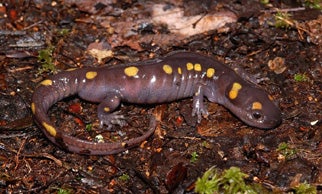SCIENTIFIC NAME:
Ambystoma maculatum
STATUS:
Uncommon to fairly common statewide except southern Coastal Plain and much of southern portions of Dougherty Plain and southern Pine Plains and Hills. Believed to be declining. Low Conservation Concern.
DESCRIPTION:
Adult spotted salamanders are typically six to eight inches long but may grow as large as 10 inches. As the name suggests this species is identified by a series of irregular shaped yellow, sometimes orange, spots running down either side of the back from the head to its tail. The base color of the head and back is dark-brown, blue-gray or solid-black with a slate gray to purplish colored belly. Spotted salamanders are thickly built, with relatively short stocky legs; each foreleg has four toes while the hind legs have five toes each. They have 11 to 13 costal grooves along the side of the body which provide additional surface area on the skin and aid them in “breathing” or respiring through their skin.
DISTRIBUTION:
Spotted salamanders can be found in appropriate habitat throughout the eastern half of the United States from Ontario east to Nova Scotia and south to Georgia and Texas. Florida, as well as southern sections of the Atlantic coastal plain are not inhabited by this species. In Alabama their distribution is essentially statewide.
HABITAT:
Spotted salamanders typically live in a variety of hardwood forests dominated by oak and hickory, near suitable breeding sites. Breeding areas include ephemeral (temporary) pools, water filled ditches, marshes and ponds about three feet deep and typically lacking predatory fish. Flood plains and lowland hardwood forests are their preferred habitats in Alabama. Adult spotted salamanders spend most of their time in burrows, in leaf litter or under rocks, bark or logs.
FEEDING HABITS:
Adults eat a variety of invertebrates and insects, including earthworms, slugs, snails, spiders, and even other salamanders. Larval forms feed on zooplankton (tiny near microscopic aquatic animals), aquatic insects, isopods, dragonfly larvae and other small aquatic invertebrates. Adults will remain dormant underground during dry conditions, but will feed during opportune times.
LIFE HISTORY AND ECOLOGY:
Spotted salamanders are solitary creatures except during the breeding season. In Alabama, breeding has been documented from late December through early February. During the breeding season, heavy nighttime rains will trigger adults to move to newly flooded breeding pools with individuals traveling from as far as 300 yards. Adults have been documented returning year after year to the same pools to breed from which they were hatched. A small percentage may stray to other areas and establish new breeding populations.
Males typically arrive first in the breeding pools. As adult females begin to arrive an unusual courtship begins. Adults swarm around one another forming a tight, twisting mass, called a “congress,” which often exceeds 100 animals. As the adults become stimulated, pairs begin to break away from the group. These pairs begin to circle one another and nudge their heads against the other’s tail. At the appropriate moment, the male will deposit a spermatophore (a packet containing sperm cells), onto leaves, twigs or vegetation in the pond. The female then picks up the spermatophore by covering it with her cloacal opening, which transfers the sperm cells to her reproductive tract, where internal fertilization occurs.
Following placement of the spermatophore, males return to the congress to continue to court other potentially receptive females. Males may drop nearly 100 spermatophores during a single breeding season.
Once impregnated females then seek out sticks or other structures in the pool on which to deposit their eggs. Egg laying typically begins 24 to 48 hours after mating. Females may deposit their eggs in one or two large masses or in several smaller ones. A single egg mass may contain 200 or more eggs. Each egg is individually enclosed in a membrane and the entire mass is surrounded by a thick, firm, jelly-like matrix. Symbiotic green alga usually develops within the inner egg capsules providing increased oxygen to the developing embryos.
Eggs will hatch in 30 to 60 days depending on weather conditions. Between two and four months later, larvae metamorphose into air-breathing land-dwelling adults. Spotted salamanders typically reach breeding size in three to five years and may live for 10 to 20 years in the wild.
REFERENCES:
Mount, R. H., 1975. The Reptiles and Amphibians of Alabama. Ala. Agri. Expt. Sta., Auburn Univ., Auburn, AL. 347 pp.
Soehren, Eric, April 2006, Outdoor Alabama. “Secretive Salamanders – A Look at Alabama’s 'Mole' Salamanders.” Alabama Department of Conservation and Natural Resources. Pages 16-19.
Shiels, A. L. Pennsylvania Angler and Boater. “Moles in the Pool: Spotted Salamanders” (Online).
https://www.fishandboat.com/Resource/AmphibiansandReptiles/Documents/molesinpool.pdf
Virginia Department of Game and Inland Fisheries 2006. “Virginia Wildlife Information: Spotted Salamander (Ambestoma maculatum)” (Online). https://www.virginiaherpetologicalsociety.com/amphibians/salamanders/spotted-salamander/index.php
Author: Ron Eakes, Wildlife Biologist, Alabama Division of Wildlife & Freshwater Fisheries






